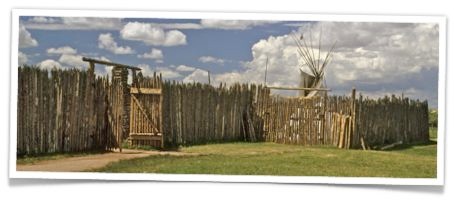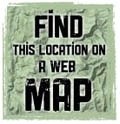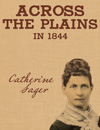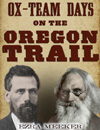Fort Bridger

ABOVE: Rebuilt Ft. Bridger. BELOW: Photo of Jim Bridger
Before arriving, many emigrants hoped that Ft. Bridger would be a civilized outpost; perhaps something similar to Ft. Laramie. Instead, Ft. Bridger was a crude collection of rough-hewn log buildings that greatly disappointed the travelers.
Emigrant Edwin Bryant:
"The buildings are two or three miserable log cabins, rudely constructed and bearing but a faint resemblance to habitable houses."
Emigrant Joel Palmer:
"It is built of poles and dabbed with mud; it is a shabby concern. Here are about 25 lodges of Indians, or rather white trapper's lodges, occupied by their Indian wives. They have a good supply of skins, coats, moccasins; which they trade for flour, coffee, sugar, etc."
The fort was built in 1843 specifically to serve the emigrant traffic. Unlike Ft. Kearny and Ft. Laramie, this fort was privately owned and operated by the legendary Jim Bridger.
Jim Bridger:
"I have established a small fort with blacksmith shop and iron in the road of the emigrants. They, in coming out, are generally well supplied with money, but by the time they get there are in want of all kinds of supplies."
Emigrant John Minto's experience at the fort was typical:
"I concluded to try if I could get a few dressed deerskins for my double-barreled gun. Jim Bridger was doing his trading--a powerful man, quick and sharp at a bargain. He said, 'young man, I can't do it, we get few deerskins here. I'll give you ten goat skins; that's the best I can do.' I started to camp satisfied with my purchase."
One key to Ft Bridger's success was its location. Unlike the rest of the region, this spot had plenty of trees and fresh water.
Emigrant Elizabeth Dixon:
"It's a pretty place to see in such a barren country. Perhaps there is a thousand acres of level land covered with grass interspersed with beautiful stoney brooks and plenty of timber."
By the time he built the fort, Bridger had become the most famous mountain man in the west. In his earlier days, he had discovered the Great Salt Lake, and helped blaze new trails across the west. In one adventure he took an arrow in the back; an arrowhead that was finally cut out three years later--without anesthetic.
Samuel Parker was there for the 'operation:'
"It was a difficult operation because the arrow was hooked at the point by striking a large bone; and cartilage had grown around it. The doctor pursued the operation with great self-possession and perseverance and the patient manifested equal firmness."
Bridger didn't operate his fort for very long--within a decade he had moved on to other adventures. Yet Bridger's departure was not a great loss for the Oregon-bound emigrants. The opening of several shortcuts had put Ft. Bridger 100 miles out-of-the-way. So, within a few years most of the emigrants were avoiding the fort anyway.




